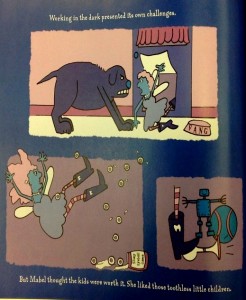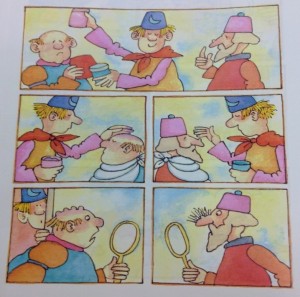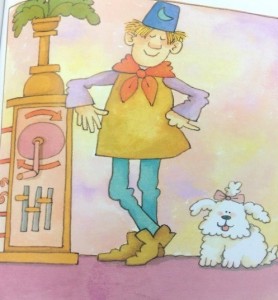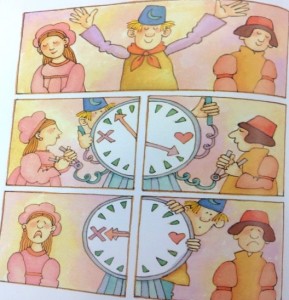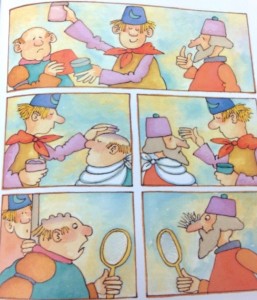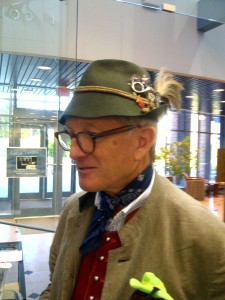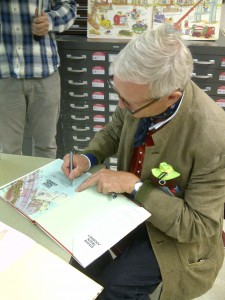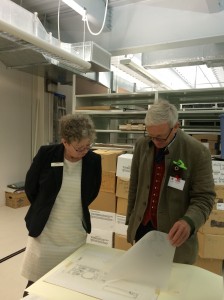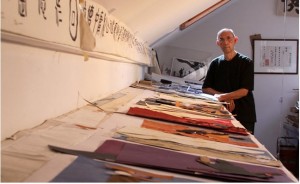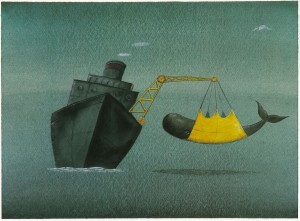Congratulations, Barbara McClintock! Where’s Mommy, written by Beverly Donofrio, has been named one of New York Times Best Illustrated Books for 2014. The NYT website reports: “Every year since 1952, the Book Review has convened an independent panel of judges to select picture books on the basis of artistic merit. The winning books are chosen from among thousands for what is the only annual award of its kind.” Fantastic news, Barbara!
Tag Archives: Northeast Children’s Literature Collection
Janet Lawler’s Blog Post 2: Looking at Layers
Looking at Layers
A picture book starts with a great story told in words (and in the sound of words read out loud). Illustrations accompany the author’s story. In the best picture books, the illustrations actually expand the story. The adult reader, as well as the child listening, feast visually on these layers that enrich the text in delightful and often unexpected ways.
As a picture book author, I focus my drafting and revision efforts on the story I want to tell. An illustrator’s considerable contribution to the final product most often comes long after I am done with my personal revision process (and any revisions guided by an acquiring editor). The publisher’s editor and art director usually select, guide, and supervise the artist. So the illustrator’s role seems a bit remote to me as I ply my craft. But remembering that layers can and should be added via art will help me create opportunities for an illustrator to deepen and expand my stories.
As I study the NCLC author/illustrator archives, I am examining the layering of art in picture books created by author/illustrators, whose creative talents allow them to tackle the words and art together. Author/illustrators don’t forget to leave room for layers—they create them as the picture book progresses in a unified way. They revise both words and illustrations to create balance and get it “just right.”
What does one find in the layers added to a picture book by illustration? Here are some thoughts, based on examples from author/illustrator archival material.
Emotion
Anita Riggio writes and illustrates from the heart. Emotion is the starting point for her wonderful stories. In Smack Dab in the Middle, Rosie Roselli is “smack dab in the middle” of her large, busy Italian family. Her many joyful accomplishments at school are ignored when she tries to share them at home, and she starts to wonder if maybe she isn’t the center of her loving family universe after all.
As I reviewed Anita’s process for Smack Dab in the Middle, I studied the text and illustrations on each spread, comparing what each separately communicates to readers. A particularly touching spread contains these words on page 20:
Rosie Roselli
really needed a hug.
She needed a hug
right this minute,
but her mother’s arms
were full of Rosie’s sister.
Rosie Roselli couldn’t wait.
She stepped up close.
She breathed in.
Talcum powder
and lavender water.
It smelled like a hug.
But it didn’t feel
like one.
Then and there,
Rosie Roselli decided
just want she
must do.
Anita’s evocative words tell us of Rosie’s need; they give the reader an expanded sense of story by dwelling on the scents (which can’t be illustrated) that she associates with her mother.
The related illustration (see below) shows Rosie’s mom’s back turned; she is attending to Rosie’s sister. Rosie’s head is bowed, her eyes are closed. The text doesn’t say, “Rosie felt disappointed, ignored, and rejected.” Those emotions are flowing from the illustration, creating a strong emotional layer to add to and support the text. (Even Anita’s placement of text and art emphasize Rosie’s loneliness here; the text snakes down the left page of this spread; there is empty space continuing onto the right page, where mom is facing away, almost out of the picture at the far right margin.)
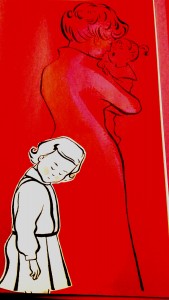 Riggio, Anita. Smack Dab In the Middle! (New York: G.P. Putnam’s Sons, 2002), 21. Photo taken from CLDC776, Archives and Special Collections at the Thomas J. Dodd Research Center, University of Connecticut Libraries.
Riggio, Anita. Smack Dab In the Middle! (New York: G.P. Putnam’s Sons, 2002), 21. Photo taken from CLDC776, Archives and Special Collections at the Thomas J. Dodd Research Center, University of Connecticut Libraries.
Plot expansion
Sometimes, illustrations take readers to places not even mentioned in the text. In Mabel the Tooth Fairy and How She Got Her Job, Katie Davis had some ideas about what might happen to a tooth fairy who works in the dark. The starting point for such an opportunity (to take the reader places) is text that is spare and full of possibilities. Here are three variations of a line of text Katie entertained (the third is final text):
After a few false starts, Mabel was considered an expert in the field.
After a few false starts, Mabel got to really like her work.
Working in the dark presented its own challenges.
All text versions support the three scenes shown below, although the final version perhaps is the funniest, with its spare understatement. The illustrations show the tooth fairy being accosted by the household mutt, slipping and falling on spilled “marbles,” and making noise by stepping on a toy horn.
The pictures transport the reader; the text does not say, “The dog of the house attacked me. I stumbled over a jar of spilled eyeballs…” Another whole layer of action/plot (with humor—the marble jar reads, “Slimy Eyeball Game”) has been added to the story through these illustrations.
Davis, Katie. Mabel the Tooth Fairy and How She Got Her Job (Orlando: Harcourt, Inc., 2003), 16. Photo taken from CLCD1438, Archives and Special Collections at the Thomas J. Dodd Research Center, University of Connecticut Libraries.
Humor
Author/illustrator Tomie dePaola also shares humor via his illustrations. His creative process for Strega Nona Meets Her Match began with a handwritten story accompanied by parenthetical notes to his editor. In this picture book, Big Anthony (Strega Nona’s loyal lunk of an assistant) “defects” to work for the competition, Strega Amelia. When Strega Amelia is away and Big Anthony is left in charge, he messes up the magic big time. Tomie’s earliest draft includes pertinent text (italicized) as well as his illustration ideas set forth in parentheses:
Big Anthony was in charge! (Series of pictures showing Big Anthony reading instructions and making big mistakes on the Husband and Wife wheel – mismatched couples – confusing wart cream and hair restorer – hair falls out, warts increase.)
Things weren’t going too well. (Source:Tomie dePaola Papers Box 41:125K).
Tomie then created illustrations (see below example of mixing up wart cream and hair restorer) to develop the humor of Big Anthony’s bumbling efforts.
Illustration for Strega Nona Meets Her Match, folder 125Y, Box 41 of Tomie dePaola papers. All rights reserved. No reproduction of any kind allowed.
What is interesting, however, is that Tomie’s editor suggested adding text to provide more at this point in the story, explaining that “for read aloud purposes it was important to have a few words.” (Source: Letter from Margaret Frith, Tomie dePaola Papers: Box 41:125L). Ultimately, the spare text was revised as suggested, and lengthened to:
Big Anthony smiled. He was in charge.
The first day he ran the husband and wife machine backwards.
The second day he confused the wart cream with the hair restorer.
Things weren’t going well.
As an author, I suspect that this lengthier text is where I would start my writing process for the same story action. How else would a reader know of the funny mishaps I envision? One possibility would be to include brief illustration suggestions to go with spare text. However, unlike an author/illustrator, who can write such notes to him or herself or to the editor (as Tomie did), an author must tread carefully when making suggestions for art so as not to be directing or limiting the illustrator’s creativity.
The right balance of text and art is achieved on pages 21–23 of the published book (see below). The complexity of Tomie’s illustration panels benefit from the added text that helps communicate his intent and humor regarding Big Anthony’s bumbling. The added text also nicely paces the story, allowing the reader to dwell on these silly mishaps.
[text: Big Anthony smiled. He was in charge.]
[text: The first day he ran the husband-and-wife machine backward.]
[text: The second day he confused the wart cream with the hair restorer.]
dePaola, Tomie. Strega Nona Meets Her Match (New York: G.P. Putnam’s Sons, 1993), 21–23. Photo taken from CLDC776, Archives and Special Collections at the Thomas J. Dodd Research Center, University of Connecticut Libraries.
Authors as well as author/illustrators must be mindful that there is a balance to be found between the read-aloud component and the illustrations in a picture book. However, an author who writes minimal text (even though he or she has a vision for what an illustrator might add) may run the risk of creating a manuscript that seems too slight or unclear to an editor, or perhaps, to young readers who may need some words to decode illustrations.
Conclusion
As I write and revise stories, I’ll keep thinking about layers. I’ll remember that my words need not dwell on emotions that an artist can convey with illustrations. I will deepen stories by words that can’t be shown in the art. I’ll choose words that may give an illustrator opportunities to take my protagonist to places (literally) other than those I may have had in mind. And if I am writing “funny,” I’ll strive for spare text that will encourage a clever artist to add visual jokes and hyperbole. I shall have trust to let an illustrator help tell my story—so that “our” story will marry text and art in a truly memorable picture book.
About Janet Lawler:
A recipient of a 2014 Billie M. Levy Research grant, Janet Lawler of Farmington, CT, is studying the relationship between art and text in picture books at the Northeast Children’s Literature Collection. Through studying the work and process of author-illustrators, she hopes to better understand how a story’s text interfaces with the art. She is searching for a deeper comprehension of why the best picture books are those where the final product is “greater” than the sum of the parts (text + illustrations). She looks forward to applying knowledge gleaned from her research to her own work process as a children’s author.
Ms. Lawler’s picture books have been published by major and specialty publishers. Two have been Children’s Book of the Month Club main selections, and two have been licensed into the Scholastic Book Clubs. If Kisses Were Colors has been translated into Spanish, Japanese, Hebrew, and Korean. Her recent credits include Ocean Counting (National Geographic, 2013 (named a 2014 Outstanding Science Trade Book by the National Science Teachers Association)) and Love Is Real (HarperCollins, 2014). National Geographic will publish Rain Forest Colors in November of 2014.
Richard Scarry II visits the NCLC
What a fantastic time we had on Sept. 19 when Richard “Huck” Scarry II visited with his lovely daughter Olympia and folks from Random House (Jason Zamajtuk, Lydia Finn, and Heidi Kilgras). We were joined by representatives from the School of Fine Arts, the English Department, the UConn Foundation, and the Neag School of Education. Huck is on a tour to promote the reissue of his father’s book “Busy, Busy World.”
Everyone had a tour of the archives, looked at some of the Richard Scarry original illustrations, listened to a tape of Huck’s mother being interviewed by Richard Scarry’s art director Ole Risom, and had a wonderful dinner in the Reading Room. Thank you, Huck and everyone, for the visit.
2014 Boston Globe-Horn Book Awards
[slideshow_deploy id=’1232′]
The winner for fiction is Andrew Smith, for Grasshopper Jungle; for nonfiction is Steve Sheinkin, for The Port Chicago 50: Disaster, Mutiny, and the Fight for Civil Rights; and for picture book, Peter Brown for Mr. Tiger goes Wild. The Honor Books winners in the fiction category are Elizabeth Wein, for Rose Under Fire and Gene Luen Yang for Boxers & Saints; for nonfiction, Steve Jenkins for The Animal Book: a Collection of the Fastest, Fiercest, Toughest, Cleverest Shyest – and Most Surprising – Animals on Earth and Patricia Hruby Powell for Josephine: the Dazzling Life of Josephine Baker;and for picture book, Daniel Beaty for Knock Knock: My Dad’s Dream for Me, and Shaun Tan for Rules of Summer. Congratulations to all!
Meet Janet Lawler, Levy Research Grant Recipient
Blog Post 1: Author-Illustrators
As a writer, I confess to a long-held jealousy of the author/illustrator who gets to “play” with both parts of the picture book package, from idea through publication. I somehow had the idea (prejudice?) that creating a picture book is easier for these multi-talented people because they can “see” the whole project; the story (and related art) must just flow for them. I suspected that their process would not include the painstaking attention that I give to every word, and to every one of multiple variations of a story.
Although I have had several well-received picture books published, I continue to strive to improve my craft. I decided that a study of the process of author/illustrators might well help me better understand the magical interface of text and art that occurs in the best picture books. I hope my research helps improve my skill as a picture book writer, even if unlocking the secrets of author/illustrators can’t turn me into an artist.
Because I mostly write for the very young, I started my research with archival material of author/illustrator Katie Davis, who also writes for this audience. While I have only completed a review of two of her picture books, Kindergarten Rocks! and I Hate to Go to Bed!, I have already learned so much. And I have totally discarded my assumptions and prejudices.
Katie’s author/illustrator process is meticulous and time-consuming. For I Hate to Go to Bed! I studied twenty-seven dummies that Katie created. Each one included text revisions and illustration revisions, as she tweaked her story in major and minor ways. It appeared that many of these versions were done as part of her creative process before she came to the point where she was satisfied and ready to show a dummy to an editor. (I hope to interview Katie, to confirm this and ask other questions).
I now think that the author/illustrator’s job of writing a story may even be harder than mine because he or she thinks visually and can see so many possibilities.
Text and illustration revision of I Hate to Go to Bed! by Katie Davis
As a representative sample, here are several text revisions Katie played with for the opening spread of this book:
I hate to go to bed! This is because I’m a very outgoing person and I can’t stand the idea that I’m missing something. And I just know I’m missing something really fantastic.
I hate to go to bed. This is because I’m a very fun person and I can’t stand the idea that I’m missing something fun. And when I’m sent to bed, I just know I’m missing something really fantastic.
I hate to go to bed! My mama and daddy absolutely swear nothing good is happening and that I won’t miss anything but I’m not too sure.
I hate to go to bed! This is because I’m a very fun person and I just know I’m missing something really fantastic.
I hate to go to bed! Because I just know I’m missing something really fantastic.
I HATE to go to bed! I just KNOW I’m missing something.
I HATE to go to bed! I just know I’m missing something!
A study of the illustrations in these many dummies reveals a similar “visual” revision process. All of the dummies show a frowning little girl (Katie captured her protagonist immediately). Some of the earliest dummies show “thought bubbles” of her parents partying after she is asleep. Others show her room with piles of toilet paper rolls (from which she later makes binoculars for spying). In some, her matching fowl (ducks/chicks?) slippers are quipping back and forth.
Here are three examples of Katie’s many illustrations drawn for the opening spread of I Hate to Go to Bed! Click on each image to enlarge.
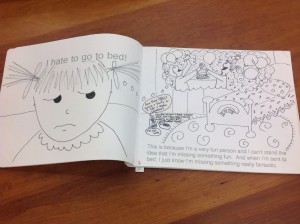
Opening spread of I Hate to Go to Bed!, 1st dummy in Box 4: Folder 15 of Katie Davis Papers. All rights reserved. No reproduction of any kind allowed.
A later version, with simplified text:
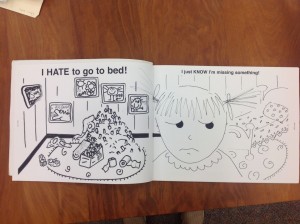
Opening spread of I Hate to Go to Bed!, 2nd dummy in Box 4: Folder 18 of Katie Davis Papers. All rights reserved. No reproduction of any kind allowed.
And the final opening spread found in the published book:
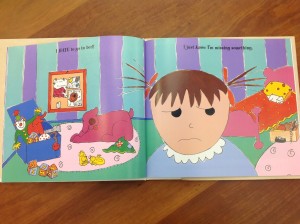
Davis, Katie. I Hate to Go to Bed! (New York: Harcourt Children’s Books, 1999), 4-5. Photo taken from : CLDC1438, Archives and Special Collections at the Thomas J. Dodd Research Center, University of Connecticut Libraries
The study of both text and illustrations reveals that Katie kept working the text and art, paring both to their essence. Her final version of the first spread immediately grabs a reader and sets the stage for the storyline to play out in a well-paced way over the rest of the book.
The frowning face of the determined protagonist remains almost identical throughout all versions of the first spread. Ultimately, that face, along with twelve words in two short sentences, clearly share her BIG problem with the reader.
Throughout the many variations of the remaining storyline, Katie explores different approaches, both with art and text, to reveal how her protagonist tackles and solves her dilemma. All versions include varied layers of meaning and humor. Sometimes, the same words, illustrated in different ways, change the plot and the story’s pacing.
How will what I’ve studied so far change my own process as an author?
I plan to slow my process down to focus more clearly on my story’s essence. I will try to pare text to get to the universal—the situation, emotion, or problem that every kid can relate to in my writing.
I hope slowing down will help me to imagine different ways the story arc might play out around the universal theme. I shall play “what if?” and “why not?” with my words in a way that will let an illustrator fill in blanks. I will strive to be less wedded to the “first” story I write; there may be other words or plot angles that offer more opportunities for an illustrator.
If I am to truly leave room for an illustrator, I need to focus even more on making every single word musical and meaningful.
Writers should make dummies as part of their process
To accomplish all of the above, or to strive to do so, I plan to create a dummy (for the text) for every story I write. I have done this with some of my manuscripts, but not all, since I have developed a good sense of story arc and appropriate length for a 32-page picture book. However, I believe parsing the text of each story I write, and placing it on the pages, will further improve my craft by encouraging me to 1) better examine what words belong on each page/spread, 2) consider whether my words allow for expansion of my story through different actions/illustrations, 3) improve forward plot motion and page turns,4) evaluate alternate story possibilities and pacing, and, just perhaps, 5) “see” more clearly how a better story might be told.
I can’t wait to start! And I can’t wait to continue my research!
Meet Janet Lawler, Levy Research Grant Recipient
Blog Post 1: Author-Illustrators
As a writer, I confess to a long-held jealousy of the author/illustrator who gets to “play” with both parts of the picture book package, from idea through publication. I somehow had the idea (prejudice?) that creating a picture book is easier for these multi-talented people because they can “see” the whole project; the story (and related art) must just flow for them. I suspected that their process would not include the painstaking attention that I give to every word, and to every one of multiple variations of a story.
Although I have had several well-received picture books published, I continue to strive to improve my craft. I decided that a study of the process of author/illustrators might well help me better understand the magical interface of text and art that occurs in the best picture books. I hope my research helps improve my skill as a picture book writer, even if unlocking the secrets of author/illustrators can’t turn me into an artist.
Because I mostly write for the very young, I started my research with archival material of author/illustrator Katie Davis, who also writes for this audience. While I have only completed a review of two of her picture books, Kindergarten Rocks! and I Hate to Go to Bed!, I have already learned so much. And I have totally discarded my assumptions and prejudices.
Katie’s author/illustrator process is meticulous and time-consuming. For I Hate to Go to Bed! I studied twenty-seven dummies that Katie created. Each one included text revisions and illustration revisions, as she tweaked her story in major and minor ways. It appeared that many of these versions were done as part of her creative process before she came to the point where she was satisfied and ready to show a dummy to an editor. (I hope to interview Katie, to confirm this and ask other questions).
I now think that the author/illustrator’s job of writing a story may even be harder than mine because he or she thinks visually and can see so many possibilities.
Text and illustration revision of I Hate to Go to Bed! by Katie Davis
As a representative sample, here are several text revisions Katie played with for the opening spread of this book:
I hate to go to bed! This is because I’m a very outgoing person and I can’t stand the idea that I’m missing something. And I just know I’m missing something really fantastic.
I hate to go to bed. This is because I’m a very fun person and I can’t stand the idea that I’m missing something fun. And when I’m sent to bed, I just know I’m missing something really fantastic.
I hate to go to bed! My mama and daddy absolutely swear nothing good is happening and that I won’t miss anything but I’m not too sure.
I hate to go to bed! This is because I’m a very fun person and I just know I’m missing something really fantastic.
I hate to go to bed! Because I just know I’m missing something really fantastic.
I HATE to go to bed! I just KNOW I’m missing something.
I HATE to go to bed! I just know I’m missing something!
A study of the illustrations in these many dummies reveals a similar “visual” revision process. All of the dummies show a frowning little girl (Katie captured her protagonist immediately). Some of the earliest dummies show “thought bubbles” of her parents partying after she is asleep. Others show her room with piles of toilet paper rolls (from which she later makes binoculars for spying). In some, her matching fowl (ducks/chicks?) slippers are quipping back and forth.
Here are three examples of Katie’s many illustrations drawn for the opening spread of I Hate to Go to Bed! Click on each image to enlarge.

Opening spread of I Hate to Go to Bed!, 1st dummy in Box 4: Folder 15 of Katie Davis Papers. All rights reserved. No reproduction of any kind allowed.
A later version, with simplified text:

Opening spread of I Hate to Go to Bed!, 2nd dummy in Box 4: Folder 18 of Katie Davis Papers. All rights reserved. No reproduction of any kind allowed.
And the final opening spread found in the published book:

Davis, Katie. I Hate to Go to Bed! (New York: Harcourt Children’s Books, 1999), 4-5. Photo taken from : CLDC1438, Archives and Special Collections at the Thomas J. Dodd Research Center, University of Connecticut Libraries
The study of both text and illustrations reveals that Katie kept working the text and art, paring both to their essence. Her final version of the first spread immediately grabs a reader and sets the stage for the storyline to play out in a well-paced way over the rest of the book.
The frowning face of the determined protagonist remains almost identical throughout all versions of the first spread. Ultimately, that face, along with twelve words in two short sentences, clearly share her BIG problem with the reader.
Throughout the many variations of the remaining storyline, Katie explores different approaches, both with art and text, to reveal how her protagonist tackles and solves her dilemma. All versions include varied layers of meaning and humor. Sometimes, the same words, illustrated in different ways, change the plot and the story’s pacing.
How will what I’ve studied so far change my own process as an author?
I plan to slow my process down to focus more clearly on my story’s essence. I will try to pare text to get to the universal—the situation, emotion, or problem that every kid can relate to in my writing.
I hope slowing down will help me to imagine different ways the story arc might play out around the universal theme. I shall play “what if?” and “why not?” with my words in a way that will let an illustrator fill in blanks. I will strive to be less wedded to the “first” story I write; there may be other words or plot angles that offer more opportunities for an illustrator.
If I am to truly leave room for an illustrator, I need to focus even more on making every single word musical and meaningful.
Writers should make dummies as part of their process
To accomplish all of the above, or to strive to do so, I plan to create a dummy (for the text) for every story I write. I have done this with some of my manuscripts, but not all, since I have developed a good sense of story arc and appropriate length for a 32-page picture book. However, I believe parsing the text of each story I write, and placing it on the pages, will further improve my craft by encouraging me to 1) better examine what words belong on each page/spread, 2) consider whether my words allow for expansion of my story through different actions/illustrations, 3) improve forward plot motion and page turns,4) evaluate alternate story possibilities and pacing, and, just perhaps, 5) “see” more clearly how a better story might be told.
I can’t wait to start! And I can’t wait to continue my research!
Ed Young donates extensive collection to Northeast Children’s Literature Collection
[slideshow_deploy id=’1094′]
Archives & Special Collections is proud to announce that Ed Young, the multi-award winning author and illustrator of children’s books, has donated his extensive collection of artwork, sketches, scrolls, storyboards, color studies and other archival materials to the Northeast Children’s Literature Collection. Mr. Young was born in Tientsin, China, lived in Shanghai and Hong Kong, and moved to the United States in 1951 to study architecture. He graduated from the Art Center College of Design in Pasadena, California, and taught at the Pratt Institute, Yale University, Naropa Institute, and the University of California at Santa Cruz.
The awards and accolades for his books are too numerous to list but include the Caldecott Medal for Lon Po Po (1989) and Caldecott Honors for The Emperor and the Kite (1967) and Seven Blind Mice (1992). His books have been named to the ALA Notable Books list seven times, have been awarded the AIGA Award: The Fifty Most Beautiful Books of the Year ten times, and have received three Boston Globe Horn Book Honor Awards. Mr. Young was also nominated in 1992 and 2000 as the U.S. representative to receive the Hans Christian Andersen Award, for “works that have made a lasting contribution to children’s literature.” Some of Mr. Young’s best-known and most-loved books are derived from Chinese folktales and include The Sons of the Dragon King (2004); Monkey King (2001); The Lost Horse (1998); Mouse Match (1997); Night Visitors (1997); Little Plum (1994); Red Thread (1993); Seven Blind Mice (1992); The Voice of the Great Bell (1989); The Eyes of the Dragon (1986); Yeh Shen (1982); White Wave (1979); Cricket Boy (1977), and 8000 Stones (1971).
The Ed Young Papers have been on deposit in the Northeast Children’s Literature Collection for approximately eighteen years. His artwork travels extensively around the world for exhibitions, including many museums in this country as well as the European Union. Mr. Young employs various media such as collage, watercolor and pastel, making his collection a treasure trove for researchers in the fine arts. The finding aid for the Ed Young Papers provides information on the more than ninety books’ worth of archival materials. Mr. Young now lives in Westchester County, New York, with his family and a cat. More information on Ed Young is available at http://edyoungart.com/. The Northeast Children’s Literature Collection holds a substantial collection of materials pertaining to children’s literature and is very grateful for this extremely important addition.
Thank you, Mr. Young!
Ed Young donates extensive archives to Northeast Children’s Literature Collection
[slideshow_deploy id=’4676′]
Archives & Special Collections is proud to announce that Ed Young, the multi-award winning author and illustrator of children’s books, has donated his extensive collection of artwork, sketches, scrolls, storyboards, color studies and other archival materials to the Northeast Children’s Literature Collection. Mr. Young was born in Tientsin, China, lived in Shanghai and Hong Kong, and moved to the United States in 1951 to study architecture. He graduated from the Art Center College of Design in Pasadena, California, and taught at the Pratt Institute, Yale University, Naropa Institute, and the University of California at Santa Cruz.
The awards and accolades for his books are too numerous to list but include the Caldecott Medal for Lon Po Po (1989) and Caldecott Honors for The Emperor and the Kite (1967) and Seven Blind Mice (1992). His books have been named to the ALA Notable Books list seven times, have been awarded the AIGA Award: The Fifty Most Beautiful Books of the Year ten times, and have received three Boston Globe Horn Book Honor Awards. Mr. Young was also nominated in 1992 and 2000 as the U.S. representative to receive the Hans Christian Andersen Award, for “works that have made a lasting contribution to children’s literature.” Some of Mr. Young’s best-known and most-loved books are derived from Chinese folktales and include The Sons of the Dragon King (2004); Monkey King (2001); The Lost Horse (1998); Mouse Match (1997); Night Visitors (1997); Little Plum (1994); Red Thread (1993); Seven Blind Mice (1992); The Voice of the Great Bell (1989); The Eyes of the Dragon (1986); Yeh Shen (1982); White Wave (1979); Cricket Boy (1977), and 8000 Stones (1971).
The Ed Young Papers have been on deposit in the Northeast Children’s Literature Collection for approximately eighteen years. His artwork travels extensively around the world for exhibitions, including many museums in this country as well as the European Union. Mr. Young employs various media such as collage, watercolor and pastel, making his collection a treasure trove for researchers in the fine arts. The finding aid for the Ed Young Papers provides information on the more than ninety books’ worth of archival materials. Mr. Young now lives in Westchester County, New York, with his family and a cat. More information on Ed Young is available at http://edyoungart.com/. The Northeast Children’s Literature Collection holds a substantial collection of materials pertaining to children’s literature and is very grateful for this extremely important addition.
Thank you, Mr. Young!
Sandra Horning’s Blog Post #3
Blog entry #3 – Meet William Gray
Looking through more than twenty boxes of the James Marshall Collection has made me feel close to this man I will never have the good fortune to meet. Marshall published about eighty books, many with both his illustrations and text. It is hard to imagine how much he would have produced if he had not died at the early age of 50. In fact, many days I have left the Dodd Center feeling a great sense of loss at his death. Through a friend, I was able to meet Marshall’s longtime partner, William Gray. I met William at the home he and James shared for much of Marshall’s career. For my final blog entry, I’ve included a few of William’s answers to the questions he generously and kindly provided. My thanks go out to William Gray for sharing his time and memories of James Marshall.
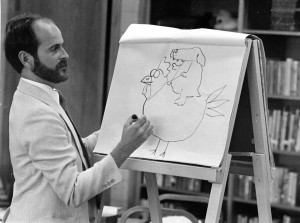
James Marshall giving a presentation (James Marshall Papers Collection File photograph, n.d.). All rights reserved. No reproduction of any kind allowed.
As I mentioned in my first blog, James Marshall wrote many of his books under the pseudonym Edward Marshall. William explained that Marshall wanted to work with more than one publisher. In order to not compete with his own picture books, the pseudonym was used and he wrote in a different genre, beginning readers. “They really suited his talent. I wouldn’t say they were easy to do just because they were easy to read. It was something that just came more naturally to him, the smaller format.”
To clarify that the comments in the margins of the dummies and manuscripts are Marshall’s, I asked about the handwriting and if William knew if anyone else wrote comments on Marshall’s work. William replied that, “He [Marshall] used a Schaefer fountain pen with those plastic capsules to draw with and to write with. He had pretty distinctive handwriting, but no one came near his work.”
I went on to ask specifically about the Harry Allard and Jeffery Allen manuscripts I discussed in my second blog post. William told me that Allard and Allen were both friends of Marshall before each collaborated on books with him. “They would mail a manuscript to him [Marshall]. He would tear it apart limb from limb and then put it back together according to what he thought was best.”
I noted that almost all of Marshall’s changes went to print and William agreed,“Oh, they made every change he suggested. He ran the show….Jim appreciated their inventiveness. I mean Harry came up with The Stupids and with Miss Nelson. But as for shaping a story, that was always Jim’s work.”
William and I talked about Marshall’s ability to critique his own work. “Jim was extremely critical of his own work and any work,” William told me. “Nothing was perfect. Even if it was a masterpiece he would find something to criticize, always. He would very seldom say, ‘I guess this is pretty good.’ He had critical faculties that kicked in and that is what kept him going.”
This comment came back to me when I went through Maurice Sendak’s bequest of additional James Marshall material. Sendak and Marshall were good friends, and Sendak owned several of Marshall’s book dummies and original artwork, most of which are now with the Marshall Collection. Among these Sendak materials is a book that Marshall created for Sendak’s birthday. The book is extraordinary, with wonderful characters wishing Maurice a happy birthday. Marshall also includes a short story from his future publication Rats on the Roof. At the end of the story, Marshall is once again critical of his endings, drawing two rats with speech bubbles. The first rat says, “Rather Chekhovian, don’t you feel?” The second rat replies, “He never could come up with decent endings.”
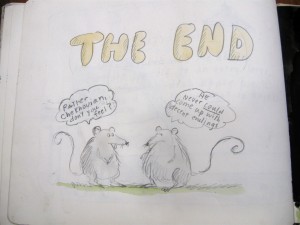
A page from the Birthday Book for Maurice Sendak from James Marshall (Maurice Sendak Collection of James Marshall Box 2012.0152.2). All rights reserved. No reproduction of any kind allowed.
I asked William if there was a work that Marshall was most proud of or that achieved what Marshall wanted? William replied, “I can tell you I really, really appreciate the Fox books. I think his talent went into that in a way that really expressed himself and certainly delights me.” William went on to say that Marshall “was kind of stuck in the George and Martha books pretty much in the framework of a relation between two people, but with the Fox books there would be all kinds of plots and subplots. None of those characters is two dimensional. In just a few sentence you know exactly who they are. I even have people say, ‘Oh, well obviously he used me for Carmen.’”
This led me to ask if Marshall was most like Fox. William said, “I think so… There is a lot of Jim in Fox.” William and I continued on to discuss the brilliant endings and humor in the Fox stories, and the way the humor was not spelled out. William said that was intentional. In fact, it was“his [Marshall’s] number one rule. Never condescend to children. Don’t do it ever.”
Most of Marshall’s sketchbooks and drafts are marked with a place and date. It became clear that he worked constantly, even while traveling. There are often to-do lists in the midst of his sketches. In one list from a trip to Cape Cod on March 10, Marshall is “working on a dummy for Yummers II, driving to Boston, going to lunch, meeting with someone from Houghton Mifflin, doing something at Nickelodeon, driving back to the Cape, picking up lamb shanks, and working in bed on Roberta Molesworthy (an iffy book).”
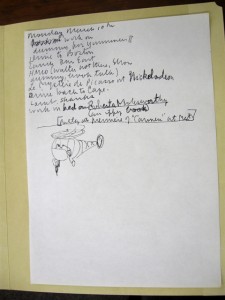
A page from Marshall’s sketches. (James Marshall Papers. Box 8:Folder 170). All rights reserved. No reproduction of any kind allowed.
The year isn’t dated, but Yummers Too was published in 1986. If Marshall was working on a dummy for this book, I can guess the date would be around 1984. Williams said that Marshall always worked. “Everything was integrated into his work.” He didn’t like to fly and preferred to work on trains. “He’d take a train to Texas or California. He loved to work on the train.”
In addition to sketchbooks, William said Marshall also kept extensive diaries. William has kept these diaries, but I did find one trip diary in the collection. The year isn’t dated, however, I can guess from what he was working on that it is probably from around 1990. The diary is all text and details his trip to New Orleans, including what he read each day: “finished a book on Janet Flanner…masterful novel by Nina Berberova, The Accompanist… Editon Wharton.”
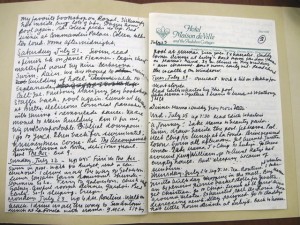
A page from Marshall’s trip diary to New Orleans. (James Marshall Papers. Box 21:Folder 299). All rights reserved. No reproduction of any kind allowed.
Marshall was also a voracious reader. William showed me the special shelves Marshall had built around his room to hold some of his books.
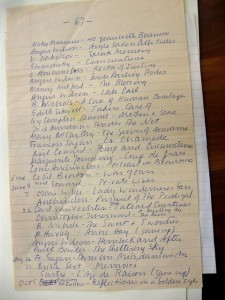
A list of books from the Marshall Collection. (James Marshall Papers. Box 21:folder 303). All rights reserved. No reproduction of any kind allowed.
William said he liked “Moliere and Chekhov…and a lot of the British women novelists like Elizabeth Taylor and Jean Rhys.” I found a piece of paper with a list of books in the collection. I am assuming these were books Marshall had read or books he purchased to read.
The page was numbered 67.
I’ve learned much in going through the Marshall papers and in talking with William Gray. James Marshall was incredibly talented in his ability to do both quality text and illustrations. He worked very hard to achieve the high quality. Going forward, it will be impossible for me to view my own work without giving it a more critical look: What would James Marshall say? He would most likely say “it could be better” and he would probably be right. Achieving the highest quality takes not only talent, but the sweat, tears, and labor of hard work. On that note, with all that I have gleaned from seeing Marshall’s process, it is time that I get back to the hard work of improving my own manuscripts. Thank you James Marshall, and thank you to the Dodd Research Center and the providers of the James Marshall Fellowship.
New Exhibition: “For Young Naturalists: Ocean Ecology in Children’s Literature”
Explore the diverse ways authors and illustrators use word and image to explain to children the complex relationships between man and the ocean in a new student-curated exhibition “For Young Naturalists: Ocean Ecology in Children’s Literature,” on display from March 27 to April 11 in the Thomas J. Dodd Research Center’s John P. McDonald Reading Room. Featuring artwork and books drawn from the Northeast Children’s Literature Collection in Archives and Special Collections, student curator Rebecca D’Angelo presents children’s books from 1844 to 2012 that illuminate how subjects such as ocean biodiversity, food security, and conservation have been depicted and narrated through time.
This exhibition is on view to coincide with the Edwin Way Teale Lectures “What role will the oceans play in meeting the global demand for food?” by Steven D. Gaines, Thursday, March 27, and “Climate, Weather, Oceans and Biodiversity: Science in Policy and Politics” by Jane Lubchenco, Thursday, April 10, 4:00pm in the Dodd Center’s Konover Auditorium.
Location: The John P. McDonald Reading Room, Archives and Special Collections at the Thomas J. Dodd Research Center, University of Connecticut, Storrs, CT
Dates: March 27-April 11, 2014
Exhibition hours: 10:00am to 4:00pm, Monday through Friday
For more information contact:
Melissa Watterworth Batt, Archives and Special Collections, Thomas J. Dodd Research
Center, UConn Libraries, melissa.watterworth@uconn.edu
New Exhibition: “For Young Naturalists: Ocean Ecology in Children’s Literature”
Explore the diverse ways authors and illustrators use word and image to explain to
children the complex relationships between man and the ocean in a new student-curated
exhibition “For Young Naturalists: Ocean Ecology in Children’s Literature,” on
display from March 27 to April 11 in the Thomas J. Dodd Research Center’s John P.
McDonald Reading Room. Featuring artwork and books drawn from the Northeast
Children’s Literature Collection in Archives and Special Collections, student curator
Rebecca D’Angelo presents children’s books from 1844 to 2012 that illuminate how
subjects such as ocean biodiversity, food security, and conservation have been depicted
and narrated through time.
This exhibition is on view to coincide with the Edwin Way Teale Lectures “What role
will the oceans play in meeting the global demand for food?” by Steven D. Gaines,
Thursday, March 27, and “Climate, Weather, Oceans and Biodiversity: Science in Policy
and Politics” by Jane Lubchenco, Thursday, April 10, 4:00pm in the Dodd Center’s
Konover Auditorium.
Location: The John P. McDonald Reading Room, Archives and Special Collections at the Thomas J. Dodd Research Center, University of Connecticut, Storrs, CT
Dates: March 27-April 11, 2014
Exhibition hours: 10:00am to 4:00pm, Monday through Friday
For more information contact:
Melissa Watterworth Batt, Archives and Special Collections, Thomas J. Dodd Research
Center, UConn Libraries, melissa.watterworth@uconn.edu
Sandra Horning’s Blog Post #2
Blog entry 2 – Every Word Counts!
All writers are familiar with the concept of “every word counts.” For writers of children’s picture books and beginning readers, every word literally counts. Most picture books published today have about 300 words. Many editors won’t even read a picture book manuscript much longer than that. Level 1 beginning readers are even shorter, with about 100 words. Keep in mind that, despite the low word count, a good story needs an arc, a plot, humor, and character development. It might seem like these stories are written quickly, and perhaps the first idea is written in a short period of time, but getting the text ready for publication can take many days, weeks, months, or longer to get right. Each word and every sentence is reviewed and revised many times. Here are some of the questions an author (and an editor) considers with each word and sentence:
Is the word necessary?
Is it the right word to convey the meaning you intend? (Does the word have more than one meaning?)
Do the challenging words have contextual clues to allow the reader to infer the definition?
Is the word count within the guidelines?
In an early beginning reader, an author needs to follow additional guidelines:
The words need to be simple enough for an emerging reader to pronounce and understand.
Contractions should be spelled out.
The words should be no more than two syllables.
Complex sentences should not be used.
The majority of the words in the text should be repeated, as you can’t introduce too many new or challenging words to an emerging reader.
I’ve been heartened to see that even someone as talented, prolific, and well known as James Marshall didn’t get every word right on his first few drafts. In looking through the dummies and drafts of his stories, I’ve enjoyed seeing his notes and eraser marks as he struggled to search for the best word.
For example, a George and Martha story usually has between 100 -150 words, but there is still much humor and character development packed into each simple story. In one of my favorites, “The Trick” in George and Martha Back in Town, George can’t resist playing tricks on Martha, so Martha plans a trick of her own. Even at the final galley stage of the book, Marshall was still requesting changes to the text. For example, the sentence
“And when she discovered that the house slippers had been nailed to the floor, she was not amused.”
was changed at the galley stage to:
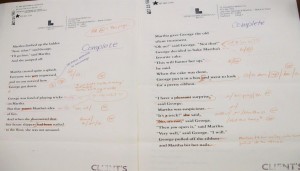
Page from galley, “The Trick” in George and Martha Back in Town (James Marshall Papers Box 8:Folder 161). All rights reserved. No reproduction of any kind allowed.
“And when she found her house slippers nailed to the floor, she was not amused.”
The final sentence is much more succinct and flows better, while still maintaining the humor. Every galley page I’ve viewed has author edits similar to this page.
In the picture book The Cut-Ups Carry On, the cut-ups Spud Jenkins and Joe Turner take dance lessons and end up entering a contest with one of them dressed as a girl. In a dummy for the book Marshall describes the scene as Spud and Joe arrive at the studio for the contest:
At the T.V. Studio, Mary Frances and Charles Andrew Frothingham were just finishing up a superb tango.
“Superb” is crossed out and “flashy” is written above it. Then “flashy” is crossed out and “dazzling” is written, which is the final version in print.
At the T.V. Studio, Mary Frances and Charles Andrew Frothingham were just finishing up a dazzling tango.
“Dazzling” is a great choice that combines the essence of both “superb” and “flashy.”
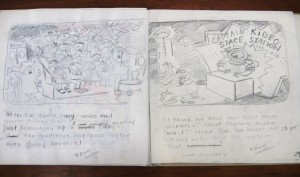
Pgs. 28-29, dummy for The Cut-ups Carry On (James Marshall Papers Box 14:Folder 238) All rights reserved. No reproduction of any kind allowed.
In a dummy for The Cut-Ups Crack Up, Marshall describes Spud and Joe as they speed around town in a “borrowed” car.
At the corner of Maple and Elm, they passed by an astonished Mary Frances and Charles Andrews.
In the final version, “passed” was changed to a much better action verb: “sailed.”
At the corner of Maple and Elm, they sailed by an astonished Mary Frances and Charles Andrew.
Again, this is a very simple word change that greatly improves the sentence.
In the dummy for the beginning reader Three Up A Tree, the story begins with the characters looking at a tree house:
Some big kids down the block had made a treehouse.
The final version reads:
Some big kids down the street had built a swell treehouse.
Three word changes, “block” to “street”, “made” to “built”, and the addition of “swell” give this sentence a boost. Now the reader can imagine the kids building a treehouse, and adding “swell” shows how much they admire it.
Marshall paid so much attention to words that he even made suggestions on other author’s manuscripts that he was illustrating. His notes and papers make it clear that he shared suggested changes to words and sentences with the authors Harry Allard (of the Miss Nelson and the Stupid series) and Jeffrey Allen (Nosey Mrs. Rat, Bonzini, and the Mary Alice stories).
In Nosey Mrs. Rat the story begins with Mrs. Rat spying on her neighbor in the bath. Allen’s original manuscript read:
“I see that you are using lilac bubble bath,” Shirley Foster said.
“I personally prefer rose.”
Mrs. Davis stepped out of the bath and locked the window.
Marshall’s suggestion for changing the last line was as follows:
Mrs. Davis pulled down the shade.
This sentence was used in the final text. With fewer words Marshall made a funnier sentence and one that also worked better for the humor in the illustration. It is easier and funnier to show a shade being pulled down than to show a window being locked.
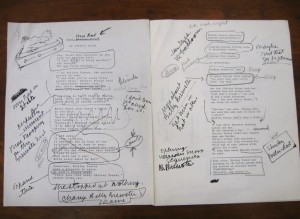
Pgs. 1-2, manuscript , Nosey Mrs. Rat (James Marshall Papers Box 8:Folder 170). All rights reserved. No reproduction of any kind allowed.
As you can see from the image, Marshall made many suggestions to Nosey Mrs. Rat. Many of them were used, including changing the title and main character from Nosey Shirley Foster to Nosey Mrs. Rat. It is rare for an illustrator to suggest text changes to the author. Most of the authors I know have never had an illustrator suggest changes. It is obvious that Marshall paid just as much attention to words, both his and others’, as he did to his illustrations. Although revising a manuscript over and over again can be tedious, Marshall’s papers and ultimately the success of his books remind me that every revision is worthwhile because every word does count, especially for the youngest readers. That said, I probably could have made this blog post a bit shorter! I will certainly be revising my work again before I send it out.

